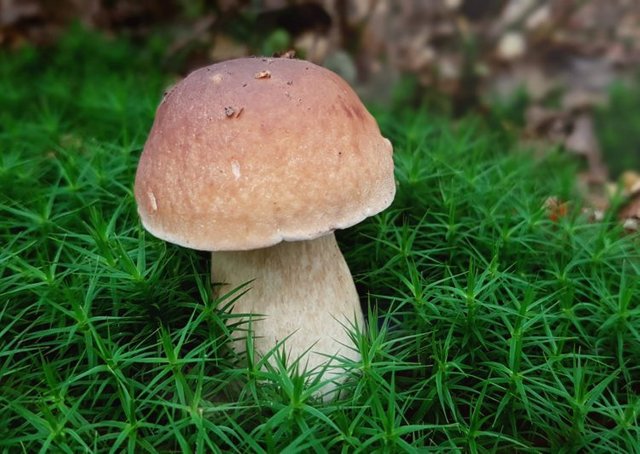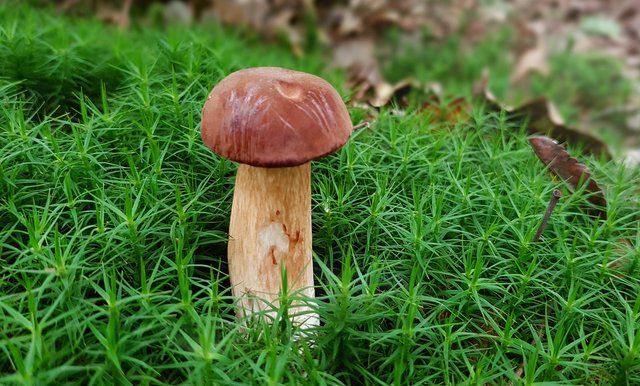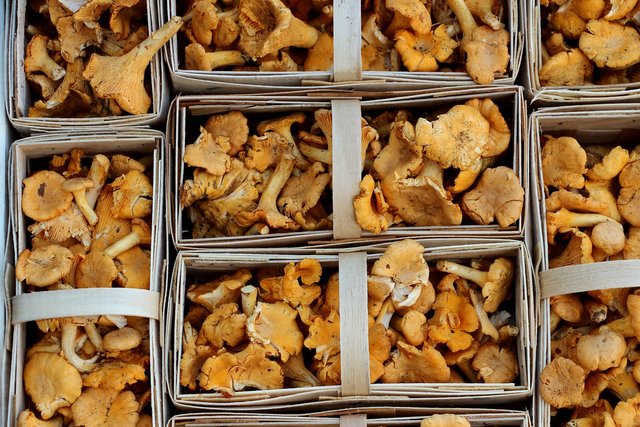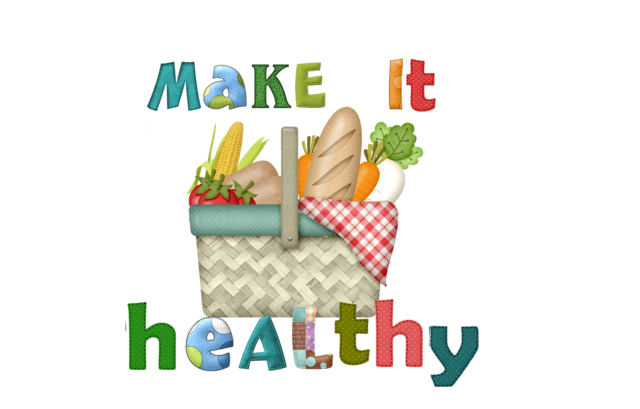It is quite a popular statement: "Mushrooms are just a flavoring and they have no nutritional value." That's what my grandma, biology teacher in primary school and many friends used to say. It's not entirely true! People know that vegetables and fruits are generally healthy. Mushrooms, however, are not plants, not animals, but a separate kingdom - simply fungi. At Christmas in Poland where I'm from, we usually eat quite a lot. We have some traditional dishes containing mushrooms in different forms: in soups, dried, sauces, in dumplings... Any vegetarian meal in Poland contains mushrooms. Let's answer the main question of the article: To eat or not eat mushrooms? Are any of them better than others? What do they contain?
I will overlook the fact that you should not eat mushrooms, which you are not 100% sure that they are edible, everyone should already know that.
POLISH VERSION OF THE POST HERE

Nutritional values of mushrooms
Different types of mushrooms differ from each other only slightly in the content of macroelements, but the data given below concern the most popular mushrooms - champignons.
100 grams (5 small pieces) contain only:
- 22 calories,
- 3.1 grams of protein,
- 3.3 grams of carbohydrates,
- and 1 gram of fiber.
Mushrooms are therefore very low in calories, they do not provide a large dose of energy, so they will work well for people wanting to lose weight. You can read more about calories here.
Much bigger difference occurs depending on the species of mushroom within minerals and vitamins. Popular champignons do not fall out that well. Seasonal forest mushrooms can be rich sources of many macroelements!
Mushrooms against anemia
Iron, an important hematopoietic element, occurs in fungi in quite a significant amount. It is characterized in this form by a relatively large absorbency, as it amounts to as much as 90%! The content of this element varies depending on the species of edible fungus from 0.5 up to 6.8 mg / 100g. Popular forest mushroom Leccinum scabrum (dried) contain as much as 7.9 mg of iron in 100 grams, and this is already 100% covered daily demand. Other particularly iron-rich species are Boletus chrysenteron, or Lepista nuda.
Here you can read about what to eat to increase IRON absorption, and here you will find out what not to eat to increase its absorption.
7 times more calcium than milk!
Some species of mushrooms can also be a great source of calcium! "Leccinum scabrum", "Lepista nuda" and "Marasmius oreades" are in the lead when it comes to the content of this strengthening bone and teeth element. In 100 grams of dried mushrooms it can be up to 880 mg of calcium! It's 7 times more than in milk!
Against hypertension
Also, the potassium content (necessary for the proper functioning of the circulatory system) in some species of mushrooms is quite significant. In addition, the fungi are characterized by low sodium content, which most of us consume way too much. It's the right balance of sodium and potassium intake that's the most important thing in treating and preventing hypertension. In terms of the amount of potassium contained, the leader of our little mushroom competition is "Suillus granulatus", this often underestimated mushroom is a real potassium bomb, the dried one contains up to 2910 mg. Noteworthy here are also "Cerioporus squamosus" and "Morchella esculenta", but generally most of the mushrooms we usually use contain a large amount of potassium and can be treated as a good source of this element.
It should be added that all the values given here refer to dried mushrooms, because the water content in mushrooms varies greatly depending on the weather and it would not be reliable to give any data in a different way.

Anti-cancer effect
For many years, fungi and mushroom extracts have been an important element of traditional medical practices of the Far East in countries such as Korea, China and Japan. The folk beliefs passed from mouth to mouth are still an important starting point for research on anticancer properties of fungi, especially in prostate, stomach and lung cancer. Polysaccharides present in mushrooms have anti-cancer and immunomodulatory properties. A special type of polysaccharides: beta-glucan, present in fungal cells, inhibits the growth of tumor cells in the case of prostate cancer. It also stimulates the immune system to fight emerging cancer cells. Aromatase inhibitors, which are produced by certain fungal species, have properties that reduce excessive levels of estrogen, which has been recognized as one of the main factors causing breast cancer in postmenopausal women.
What interesting, mushrooms are the only (except for the sun) non-animal source of vitamin D. They contain more than 10 times more vitamin D than milk - up to 18 units. The consumption of mushrooms does not, however, exempt from mandatory supplementation with this vitamin in autumn and winter.
For diabetics and against diabetes!
The very fact that mushrooms are low in easily absorbing carbohydrates makes them a beneficial food for diabetics and in the prevention of this disease. In addition, the low Glycemic Index, the soluble and insoluble fiber content, which regulates blood sugar, are further arguments for including mushrooms in the diet. They are also low-calorie, so (unless you eat them in the form of a cream sauce covered with butter and cheese) it is a good product for people trying to limit calories intake in their diet.

The fight against parasites
Especially chanterelle play an interesting role here. Ignited mushroom pickers probably noticed that these yellow mushrooms are almost never wormy. It is thanks to its content of hitinmannoza. Hitimannoza is a compound with very strong anti-parasitic properties. It is used in some pharmaceuticals, works by paralyzing the nervous system of the parasite. Unfortunately, it is not temperature-resistant, and it is deactivated in 55 degrees. Folk methods using cocks in antiparasitic treatments recommend drying, grinding and later cold use as an addition to dishes.
Fact, however, are hard to digest
Mushrooms, however, will not be suitable food for everyone. They are hard to digest and should be avoided by people with problems with the digestive system, the elderly and small children. Moderation in their consumption is also indicated, even if you do not have any digestive issues.
Origin is important
Mushrooms very strongly absorb ingredients from the environment in which they are found. Both, good and bad. So if we are dealing with a mushroom found in the middle of the forest, far from factories and roads, it will contain much more beneficial ingredients than one that grew close to the expressway and can be a source of pesticides or heavy metals. Mushrooms collected by ourselves or purchased from sellers in the vicinity of forests are much better than mushrooms from a supermarket of unknown origin!
Summary
Mushrooms, in addition to the specific flavor desired in the kitchen, may add extra health value to the dishes. It may not be a food for the name of superfoods, but the low calorie content of mushrooms provides them with high nutritional density. It is worth to include them in the menu! It must be remembered, however, that mushrooms are hard to digest and therefore not recommended to everyone!
Make sure to check out a lovely initiative by @woman-onthe-wing #makeithealthy here
Sources
HüseyinGençcelepa; Determination of mineral contents of wild-grown edible mushrooms; Food Chemistry; vol 113, 2009, Pages 1033-1036
Hüseyin Gençcelep, Determination of mineral contents of wild-grown edible mushrooms; Food Chemistry 113 (2009) 1033–1036
Kalac, P., & Svoboda, L. (2000). A review of trace element concentrations in edible mushrooms. Food Chemistry, 69, 273–281.
Pathirage Kamal Perera , Yunman Li; Mushrooms as a functional food mediator in Preventing and ameliorating diabetes; Functional Foods in Health and Disease 2011; 4:161-171
S. Wasser; Medicinal mushrooms as a source of antitumor and immunomodulating polysaccharides;
Applied Microbiology and Biotechnology November 2002, Volume 60, pp 258–274
ShaileshDudhgaonkara, AnitaThyagarajana; Suppression of the inflammatory response by triterpenes isolated from the mushroom Ganoderma lucidum;; International Immunopharmacology; vol 9,2009, 1272-1280
They do add a lot flavor too! Umami
Downvoting a post can decrease pending rewards and make it less visible. Common reasons:
Submit
true that! :) lovely ingredient
Downvoting a post can decrease pending rewards and make it less visible. Common reasons:
Submit
I love mushrooms :) I'm glad to hear they're so healthy, I had no idea they'd such a high Ca2+ content! Yay!
Just a few quick points )
Downvoting a post can decrease pending rewards and make it less visible. Common reasons:
Submit
I was going to write exactly that. That I love them and I eat loads of raw champignons.
I did a search to find out if eating them raw is ok and found out that it's safe but eating too many might cause kidney dust due to soil residue. And I eat them unwashed since I feel that the aroma is gone when properly washed. But then I am a weirdo, so don't mind me :D
Downvoting a post can decrease pending rewards and make it less visible. Common reasons:
Submit
Haha I've never heard of this 'kidney dust'... worth looking in to?
Never even considered eating them raw... i love them caramalised with onions!
Downvoting a post can decrease pending rewards and make it less visible. Common reasons:
Submit
I also sometimes eat them raw, but only when I'm really hungry and can't wait for them to caramelise :D
Downvoting a post can decrease pending rewards and make it less visible. Common reasons:
Submit
Thanks guys for your help!
I've made a mistake with the Fungi because in polish translation: fungi and mushrooms are the same word :D always good to learn something new, thanks for that :)
After rethinking: I agree with everything that you've written! Scientifically proven is too strong, I should have said evidence-based instead. I'll edit the title.
Downvoting a post can decrease pending rewards and make it less visible. Common reasons:
Submit
:D classic translation errors :)
Downvoting a post can decrease pending rewards and make it less visible. Common reasons:
Submit
Hi @ann.urbanska:)
Please, can you confirm if the images used are your own?
Thank you
(steemstem curator)
Downvoting a post can decrease pending rewards and make it less visible. Common reasons:
Submit
Hello, sure :) These are not my own photos, but they are all Creative Commons (CC0) licensed. Here are the links to photo stocks I used:
https://pixabay.com/pl/grzyb-cep-mech-gwiazda-moss-2678081/
http://maxpixel.freegreatpicture.com/Island-Miniature-Simple-Cartoon-Mushrooms-Fungus-1662959
https://pixabay.com/pl/grzyb%C3%B3w-pieprznik-jadalny-rynku-1623893/
https://pixabay.com/pl/grzyb-kasztan-grzyb-mech-2678105/
With CC0 there is no need to credit the author, in any other case I would do so :)
Downvoting a post can decrease pending rewards and make it less visible. Common reasons:
Submit
Never knew mushrooms had so much benefits, thank you - he says as he chews a piece of mushroom :)
Downvoting a post can decrease pending rewards and make it less visible. Common reasons:
Submit
haha, you're welcome! It's my mission - provide Steemit with evidence-based, interesting nutrition facts :)
Downvoting a post can decrease pending rewards and make it less visible. Common reasons:
Submit
To eat or not to eat?? That is the question...and my answer is - Yes!! :) I love forest/wild mushrooms...( being Polish as you ) I think all Polish people love them...they are very popular in Europe...and other world locations...very interesting and detailed post...taking it with me...pozdrawiam seredcznie, Aniu :)
Downvoting a post can decrease pending rewards and make it less visible. Common reasons:
Submit
Pozdrawiam także serdecznie! :)) Dziękuję za miły komentarz
Downvoting a post can decrease pending rewards and make it less visible. Common reasons:
Submit
Dziękuję za fajną lekturę. Pozdrawiam z Filipin.
Downvoting a post can decrease pending rewards and make it less visible. Common reasons:
Submit
Thanks for sharing those wonderful reminders of the mushroom.
I didn’t realize they were high in calcium.
Downvoting a post can decrease pending rewards and make it less visible. Common reasons:
Submit
I was shocked to find it out too!
Downvoting a post can decrease pending rewards and make it less visible. Common reasons:
Submit
Being A SteemStem Member
Downvoting a post can decrease pending rewards and make it less visible. Common reasons:
Submit
Thank you! :)
Downvoting a post can decrease pending rewards and make it less visible. Common reasons:
Submit
Uwielbiam grzyby,ale niestety ograniczona jestem tylko do pieczarek (które muszę spożywać sporadycznie) ze względu na moją wątrobę :-/
A tak w ogóle to fajny post, tyle ciekawych rzeczy na ich temat się dowiedzałam.
Downvoting a post can decrease pending rewards and make it less visible. Common reasons:
Submit
Bardzo mi miło :) Wiadomo, niestety nie dla wszystkich będą grzyby dobre. Tak samo jak każde jedzenie z resztą, Dla przykładu mleko będzie dla jednego dobrym pokarmem, innemu może szkodzić... Takich przykładów można podać tysiąc, ważne zeby zidentyfikować te dla nas dobre produkty i na nich bazować :)
Downvoting a post can decrease pending rewards and make it less visible. Common reasons:
Submit
Super post i fajnie opisane o grzybkach. Lubie grzyby i bardzo często dodaje do wielu potraw !!! Pozdrawiam !!!
Downvoting a post can decrease pending rewards and make it less visible. Common reasons:
Submit
To go mushrooming is a national sport in Poland, can't wait til the season starts, looking forward for some parasols, saffron milk cups which are abundand but so tasty and a few boletus, maybe even a royal bolete :)
There is a really good app, the Mushroom Book, and obviously from a Polish developer:)
Downvoting a post can decrease pending rewards and make it less visible. Common reasons:
Submit
Congratulations, your post has been featured in issue #3 of The Make It Healthy Project MAGAZINE!

Downvoting a post can decrease pending rewards and make it less visible. Common reasons:
Submit